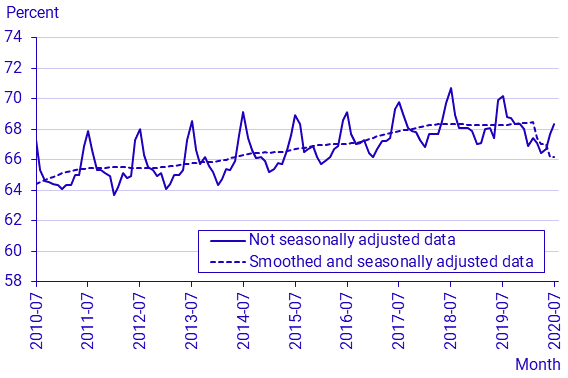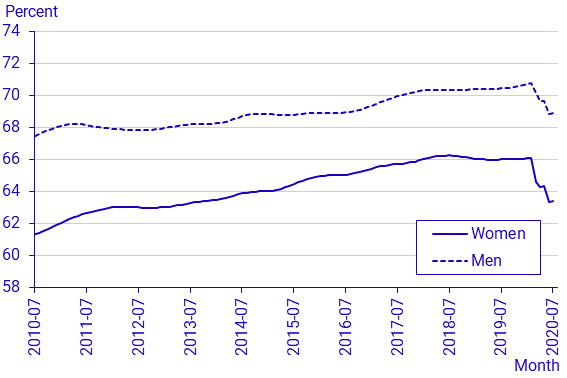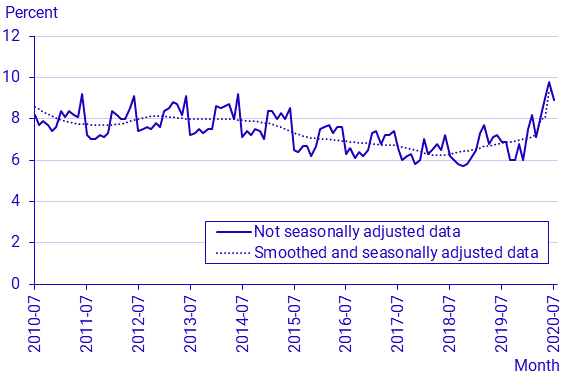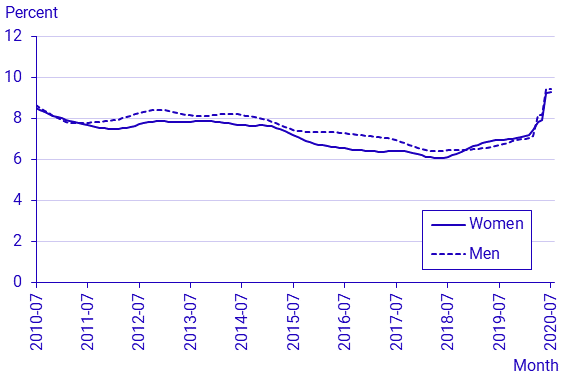Labour Force Surveys (LFS), July 2020
Labour market situation remains tough for young people
Statistical news from Statistics Sweden 2021-01-28 9.30
In July 2020, there were 5 150 000 employed persons, which is 120 000 fewer than in July 2019. The number of unemployed persons increased by 112 000 to 502 000. This corresponds to an unemployment rate of 8.9 percent, up by 2.0 percentage points. Among young people, the unemployment rate increased by 7.0 percentage points to 23.0 percent. Average hours worked amounted to 98.7 million hours per week, a decrease of 6.0 percent, calendar adjusted. According to seasonally adjusted and smoothed data, employment decreased, while unemployment increased compared with February 2020. The unemployment rate was 9.4 percent.
The labour force
In July 2020, there were 5 652 000 persons aged 15–74 in the labour force, not seasonally adjusted. There were 2 983 000 men and 2 668 000 women in the labour force. The relative labour force participation rate was 75.0 percent. Among men, this rate was 77.8 percent and among women the rate was 72.1 percent.
Seasonally adjusted and smoothed data shows that there were 5 506 000 persons in the labour force, a decrease of 45 000 persons compared with February 2020, when the effects of the coronavirus (COVID-19) outbreak were not yet discernible in the Swedish labour market. The labour force participation rate was 73.0 percent, a decrease of 0.7 percentage points compared with February 2020. It is worth noting that this downturn both with regard to the number and the share of persons in the labour force, has halted in the last four months.
Employment
In July 2020, there were 5 150 000 employed persons aged 15─74, not seasonally adjusted. This is a decrease of 120 000 persons compared with July 2019, of whom 95 000 persons were aged 15-24 years. There were 2 439 000 employed women, which is a decrease of 66 000, and there were 2 711 000 employed men. The employment rate was 68.3 percent, which is a decrease of 1.9 percentage points. Among men, the employment rate fell by 1.7 percentage points to 70.7 percent and among women the employment rate fell by 2.0 percentage points and amounted to 65.9 percent.
Seasonally adjusted and smoothed data shows that there were 4 991 000 employed persons, which is 165 000 fewer than in February 2020, of whom 78 000 persons were aged 15─24 years. The employment rate among persons aged 15─74 years was 66.2 percent, a decrease of 2.3 percentage points compared with February 2020.
Employees
In July 2020, there were 4 610 000 employees, not seasonally adjusted. This is 108 000 fewer than in the corresponding month last year. Among men, there were 2 315 000 employees. Among women, there were 2 295 000 employees, which is a decrease of 65 000. There were 3 799 000 permanent employees. Among men, the number of permanent employees was 1 951 000 and among women it was 1 848 000.
There were 811 000 temporary employees, which is 83 000 fewer than in the corresponding month last year. There were 446 000 temporary employed women, which is a decrease of 52 000. There were 364 000 temporary employed men. Among young people aged 15-24 years, the number of temporary employees amounted to 338 000, a decrease of 70 000.
Compared with February 2020, smoothed and seasonally adjusted data shows a decrease of 160 000 in the number of employees, of whom 117 000 were temporary employees.
Hours worked
The average number of hours worked in July 2020 amounted to 98.7 million per week, not seasonally adjusted. In calendar-adjusted figures, this corresponds to a decrease of 6.0 percent compared with the corresponding month a year ago. The largest decrease was in the hotels and restaurants sector, where the number of hours worked, calendar adjusted, decreased by 28.0 percent compared with July 2019. Hours worked decreased by 25.0 percent in the transport sector and by 10,5 percent in the Health and social care sector.
Seasonally adjusted and smoothed data shows that the average number of hours worked per week amounted to 144.3 million. This is 11.6 million hours per week less than in February 2020. On the other hand, the number of hours worked has not decreased since April.
In work and absence
There were 2 842 000 persons employed and in work in July 2020, not seasonally adjusted. The LFS estimates the number of persons who were absent for the whole week or for part of the week from their principal occupation by main reason for absence. There were 2 343 000 persons absent for the whole week in July 2020, not seasonally adjusted. Among these, 99 000 were absent due to illness, 22 000 were absent for the whole week due to lack of work, and 23 000 were absent due to lay-offs. There were 1 975 000 persons absent due to holidays.
Among persons who were absent due to lack of work or lay-offs, absence during only part of the week was common. There were 93 000 persons in total absent for the whole week or part of the week due to lay-offs. The information about the number of lay-offs during July should be interpreted with some caution, as persons who were laid off and who were on holiday in July may have stated holidays as their main reason for absence. There were 66 000 persons who stated lack of work as their main reason for absence.
Seasonally adjusted and smoothed data showed that there were 4 201 000 persons in work, which is 169 000 fewer than in February 2020. There were 790 000 persons absent for the entire week.
Unemployment
In July 2020, there were 502 000 unemployed persons aged 15–74 years, not seasonally adjusted, which is 112 000 more than in the corresponding month a year ago. The unemployment rate was 8.9 percent, which is an increase of 2.0 percentage points. The number of unemployed men increased by 76 000 and amounted to 272 000. There were 230 000 unemployed women. The unemployment rate was 8.6 percent among women, which is an increase of 1.4 percentage points. Among men, the unemployment rate increased by 2.5 percentage points to 9.1 percent.
There were 164 000 unemployed young people aged 15–24 years. This is 42 000 more than in the corresponding month last year. The unemployment rate among young people was 23.0 percent, which is an increase of 7.0 percentage points.
Among persons aged 15–74 years, seasonally adjusted and smoothed data shows 120 000 more unemployed persons than in February 2020. This corresponds to an increase of the share of unemployed persons by 2.2 percentage points. In July 2020, there were 515 000 unemployed persons, which corresponds to an unemployment rate of 9.4 percent.
Among young people aged 15–24, seasonally adjusted and smoothed data shows an increase in both the nber and share of unemployed persons compared to February 2020. The number of unemployed young people increased by 48 000 and amounted to 172 000, and the unemployment rate increased by 9.0 percentage points to 28.9 percent.
Impact of COVID-19 on the labour market
In view of the ongoing coronavirus (COVID-19) pandemic, additional questions concerning the impact of COVID-19 have been added to the LFS. Based on these questions, 115 000 employed persons aged 15–74 years stated that they were absent during the whole reference week related to COVID-19. This means that among persons who were absent during the entire reference week, 5.0 percent were absent due to COVID-19. This proportion was 5.5 percent among men and 4.4 percent among women.
Among employees aged 15–74 years who were absent during the entire reference week, 4.1 percent, which corresponds to 88 000 persons, stated that their absence was linked to COVID-19. This proportion was 4.2 percent among men and 4.0 percent among women. Furthermore, among employees who were absent during part of the week, 104 000 persons, that is, 22.8 percent, stated that their absence was linked to COVID-19. Among self-employed persons and unpaid family members aged 15–74 years, 42.6 percent felt that they had less work due to the coronavirus pandemic, while 15.4 percent felt that they had more work.
Among persons who were not employed and who have left their employment since March, 88 000 stated that this was as a consequence of the pandemic.
To be classified as unemployed in the LFS, a person must be without a job, must be able to start work and must have sought work. This means that people who are without a job, but who have not been seeking work or are not available to start work are not classified as being unemployed, but are, instead, not in the labour force. In July 2020, 1 884 000 persons aged 15–74 years were outside the labour force. Among these people, 95 000 stated that they would have been available to work, but had not looked for work due to COVID-19.




Next publishing will be
2020-09-15 at 9:30.
Feel free to use the facts from this statistical news but remember to state Source: Statistics Sweden.
